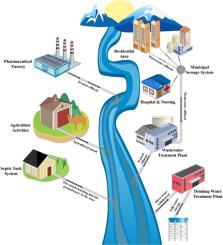Journal of Hazardous Materials ( IF 13.6 ) Pub Date : 2021-06-18 , DOI: 10.1016/j.jhazmat.2021.126418 Efaq Noman 1 , Adel Al-Gheethi 2 , Radin Maya Saphira Radin Mohamed 2 , Balkis Talip 3 , Mohamed Al-Sahari 2 , Muhanna Al-Shaibani 2

|
The current review highlighted the quantitative microbiological risk assessment of Vibrio parahaemolyticus in Prawn farm wastewaters (PFWWs) and the applicability of nanoparticles for eliminating antibiotic-resistant bacteria (ARB). The high availability of the antibiotics in the environment and their transmission into human through the food-chain might cause unknown health effects. The aquaculture environments are considered as a reservoir for the antibiotic resistance genes (ARGs) and contributed effectively in the increasing of ABR. The metagenomic analysis is used to explore ARGs in the non-clinical environment. V. parahaemolyticus is among the pathogenic bacteria which are transmitted through sea food causing human acute gastroenteritis due to available thermostable direct hemolysin (tdh), adhesins, TDH related hemolysin (trh). The inactivation of pathogenic bacteria using nanoparticles act by disturbing the cell membrane, interrupting the transport system, DNA and mitochondria damage, and oxidizing the cellular component by reactive oxygen species (ROS). The chloramphenicol, nitrofurans, and nitroimidazole are among the prohibited drugs in fish and fishery product. The utilization of probiotics is the most effective and safe alternative for antibiotics in Prawn aquaculture. This review will ensure public understanding among the readers on how they can decrease the risk of the antimicrobial resistance distribution in the environment.
中文翻译:

对虾养殖废水中复杂微生物群落的定量微生物风险评估以及纳米颗粒和益生菌在消除抗生素抗性细菌中的适用性
目前的审查强调了对虾养殖场废水 (PFWWs)中副溶血性弧菌的定量微生物风险评估以及纳米颗粒在消除抗生素抗性细菌 (ARB) 中的适用性。环境中抗生素的高可用性及其通过食物链传播给人类可能会导致未知的健康影响。水产养殖环境被认为是抗生素抗性基因(ARGs)的储存库,并有效地促进了 ABR 的增加。宏基因组分析用于探索非临床环境中的 ARG。副溶血性弧菌由于可用的耐热直接溶血素 ( tdh )、粘附素、TDH 相关溶血素 ( trh)。使用纳米粒子灭活病原菌的作用是干扰细胞膜、中断运输系统、DNA 和线粒体损伤,以及通过活性氧 (ROS) 氧化细胞成分。氯霉素、硝基呋喃和硝基咪唑是鱼类和渔业产品中的禁用药物。益生菌的利用是对虾养殖中抗生素最有效、最安全的替代方案。该审查将确保读者了解如何降低环境中抗菌素耐药性分布的风险。



























 京公网安备 11010802027423号
京公网安备 11010802027423号